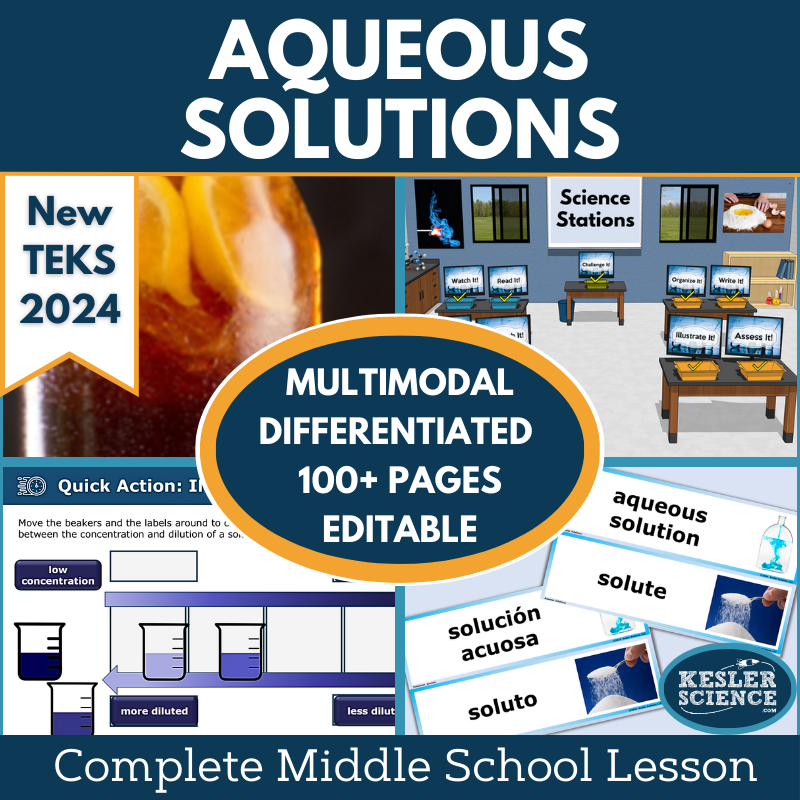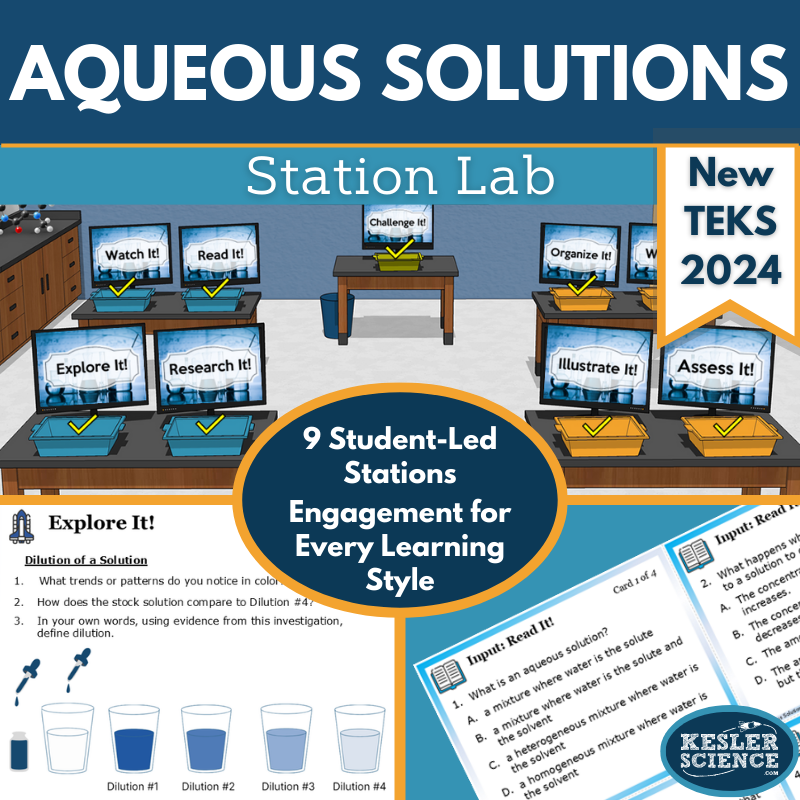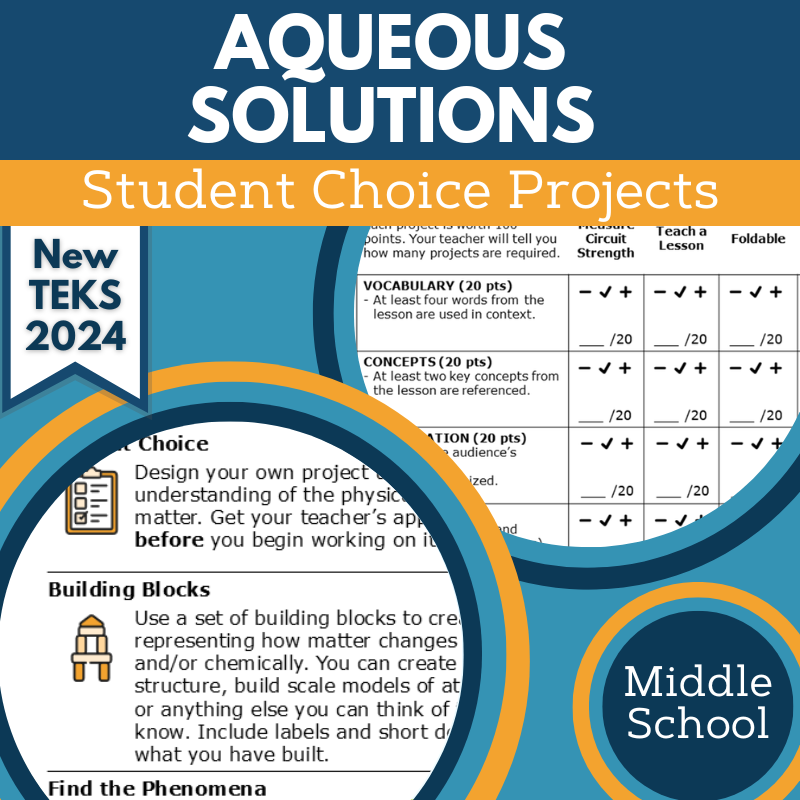Aqueous Solutions Activities for Middle School Science
Help middle school students understand dilution and concentration in aqueous solutions with this engaging 5E lesson. The resources below will give students a comprehensive understanding of aqueous solutions. All of the following materials are also included in the Kesler Science Membership.
The Kesler Science 5E Lesson on dilution and concentration of aqueous solutions is a comprehensive, student-led unit designed for middle school chemistry. It includes editable presentations, worksheets, assessments, and choice projects that support differentiated, multimodal learning. The lesson aligns with the 2021 TEKS 7.6D standard and is available in both digital and print formats, with Spanish translations of key materials.
Following the 5E Model, students engage with vocabulary word walls and discussions to address essential questions about aqueous solutions. A hands-on, student-led station lab provides various input and output stations, including experiments, reading passages, research activities, videos, categorization tasks, writing prompts, and visual exercises. A challenge station offers extension activities for early finishers. Explanation resources include editable PowerPoints, interactive notebooks, and note-taking templates in English and Spanish. Students elaborate through choice projects and evaluate their understanding with STAAR 2.0-aligned assessments and review worksheets.
This flexible, low-prep lesson is ideal for in-class or virtual learning, providing engaging ways for students to explore how dilution impacts concentration in aqueous solutions.
The Kesler Science 5E Lesson on dilution and concentration of aqueous solutions is a comprehensive, student-led unit designed for middle school chemistry. It includes editable presentations, worksheets, assessments, and choice projects that support differentiated, multimodal learning. The lesson aligns with the 2021 TEKS 7.6D standard and is available in both digital and print formats, with Spanish translations of key materials.
Following the 5E Model, students engage with vocabulary word walls and discussions to address essential questions about aqueous solutions. A hands-on, student-led station lab provides various input and output stations, including experiments, reading passages, research activities, videos, categorization tasks, writing prompts, and visual exercises. A challenge station offers extension activities for early finishers. Explanation resources include editable PowerPoints, interactive notebooks, and note-taking templates in English and Spanish. Students elaborate through choice projects and evaluate their understanding with STAAR 2.0-aligned assessments and review worksheets.
This flexible, low-prep lesson is ideal for in-class or virtual learning, providing engaging ways for students to explore how dilution impacts concentration in aqueous solutions.
Engage your middle school students with this student-led station lab aligned to TEKS 7.6D, covering aqueous solutions. Designed for in-class or virtual learning, this activity guides students in exploring solute and solvent interactions, concentration, and dilution through nine interactive stations.
Students engage with new concepts through videos, readings, research, and hands-on activities. They demonstrate their learning by organizing information, illustrating models, writing responses, and completing assessments. A bonus challenge station provides extension activities, and differentiated reading passages in English and Spanish support diverse learners.
This low-prep, high-engagement resource promotes active learning and critical thinking.
Engage your middle school students with this student-led station lab aligned to TEKS 7.6D, covering aqueous solutions. Designed for in-class or virtual learning, this activity guides students in exploring solute and solvent interactions, concentration, and dilution through nine interactive stations.
Students engage with new concepts through videos, readings, research, and hands-on activities. They demonstrate their learning by organizing information, illustrating models, writing responses, and completing assessments. A bonus challenge station provides extension activities, and differentiated reading passages in English and Spanish support diverse learners.
This low-prep, high-engagement resource promotes active learning and critical thinking.
The Aqueous Solutions Student Choice Projects align with the 2021 TEKS standard 7.6D, offering middle school students a variety of project options to demonstrate their understanding. A project page outlines six structured choices plus a “design your own” option, all supported by an editable rubric for teacher, peer, or self-assessment.
These flexible, multimodal projects allow for differentiation, with a modified version providing three targeted options for students needing support as well as opportunities for advanced learners to complete multiple projects using the same rubric. Teachers can customize the rubric to fit their grading needs.
Projects require standard classroom supplies like paper, markers, and scissors, with many available for digital completion.
The Aqueous Solutions Student Choice Projects align with the 2021 TEKS standard 7.6D, offering middle school students a variety of project options to demonstrate their understanding. A project page outlines six structured choices plus a “design your own” option, all supported by an editable rubric for teacher, peer, or self-assessment.
These flexible, multimodal projects allow for differentiation, with a modified version providing three targeted options for students needing support as well as opportunities for advanced learners to complete multiple projects using the same rubric. Teachers can customize the rubric to fit their grading needs.
Projects require standard classroom supplies like paper, markers, and scissors, with many available for digital completion.
Year-Round Resources
These year-round activities will increase your students' understanding of many middle school science topics. All of these activities are also included in the Kesler Science Membership.
Visual Data & Graphing
You're not alone if your students struggle with understanding graphs, charts, and tables. It's a skill that takes an enormous amount of practice. This resource will help students build a strong foundation in analyzing data and creating their own data visualizations.
Bell Ringers and Warm-Ups
These middle school science bell ringers are an excellent way to engage your students as soon as they walk into your classroom. This comprehensive FULL YEAR resource includes everything you need to start off each science class with an interesting warm-up activity.
Review Board Games
Each game board has been carefully designed to keep students engaged. There are 10 different action spaces on each board and dozens of question cards. All of the actions are related to science concepts and keep the students motivated throughout the game.
Each game is ready to play. Simply print out the board and the cards and let the students enjoy reviewing nine different units.
Essential Questions and Standards
Below are the essential questions and standards associated with the lessons and activities included in the atoms unit. This topic is only one of more than 100 middle school science topics included in the Kesler Science Membership.
-
What are the components of an aqueous solution?
-
How does dilution impact the concentration of a solution?
-
TEKS Science - 7.6D Aqueous Solutions
Kesler Science Membership
Imagine never having to search for another middle school science lesson again. The membership gives you access to ALL of the Kesler Science products in one place (Yes, including everything above).
Say goodbye to long hours of lesson prep.







